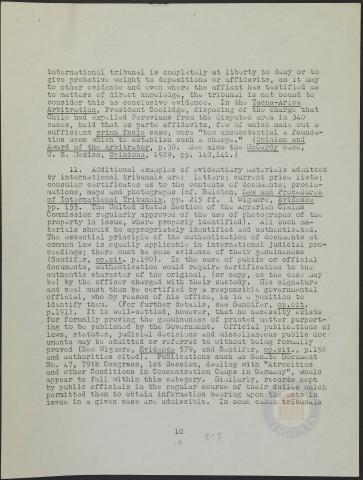
Page 10
| Parent | Perpetuation of testimony by Witnesses in U. S. for Presentation to the International Military Tribunal |
|---|---|
| Date | 18 June 1945 |
| Language | English |
| Collection | Tavenner Papers & IMTFE Official Records |
| Box | Box 3 |
| Folder | General Reports and Memoranda from June 1946 |
| Repository | University of Virginia Law Library |
international tribunal is completely a t liberty to deny or to give probative weight to depositions or affidavits, as it may to other evidence or even where the affiant has testified as to matters of direct knowledge, the tribunal is not bound to consider this as conclusive evidence. In the Tacna-Arica Arbitration, President Coolidge, disposing of the charge that Chile had expelled Peruvians from the disputed area in 340 cases, held that ex parte affidavits, few of which made out a sufficient prima facie case, were “too unsubstantial a foundation upon which to establish such a charge.” (Opinion and Award of the Arbitrator, p. 30. See also the McCardy case, U. S. Mexico, Opinions, 1929, pp. 140, 141.)
11. Additional examples of evidentiary materials admitted by international tribunals are: letters, current price lists; consular certificates as to the contents of documents; proclamation, maps and photographs (cf. Ralston, Law and procedures of International Tribunals, pp. 215 ff. 1 Wigmore, Evidence pp. 155. The United States Section of the Agrarian Claims Commission regularly approved of the use of photographs of the property in issue, where properly identified.). All such materials should be appropriately identified and authenticated. The essential principle of the authentication of documents and common law is equally applicable in international judicial proceedings; there must be some evidence of their genuineness (Sandifer, op.cit. p. 190). In the case of public or official documents, authentication would require certification to the authentic character of the original, (or copy, as the case may be) by the officer charged with their custody. His signature and seal must then be certified by a responsible governmental official, who by reason of his office, is in a position to identify them. (For further details, see Sandifer, op.cit. p. 191). It is well=-settled, however, that no necessity exists for formally proving the genuineness of printed matter purporting to be published by the Government. Official publications of laws, statutes, judicial decisions and miscellaneous public documents may be admitted or referred to without being formally proved (See Wigmore, Evidence 579, and Sandifer, op.cit., p. 198 and authorities cited). Publications such as Senate Document No. 47, 79th Congress, 1st Session, dealing with “Atrocities and other Conditions in Concentration Camps in Germany”, would appear to fall within this category. Similarly, records kept by public officials in the regular course of their duties which permitted them to obtain information bearing upon the acts in issue in a given case are admissible. In some cases tribunals
10
